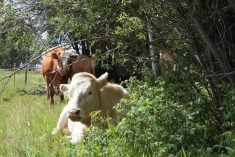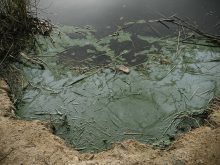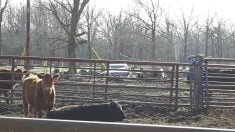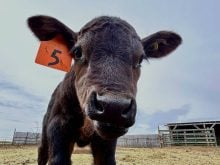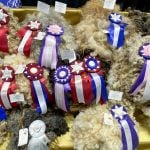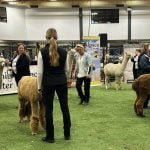After all these years, implanting is still one of the most underutilized management tools in beef production.
The feedlot sector has pretty much adopted implanting routinely, but the cow-calf sector lags far behind. It is one thing if “natural, hormone-free, or organic” beef is being raised and implants must be avoided as part of these programs. But with those types of programs you should be receiving approximately a 20 per cent premium to justify the extra costs in raising beef.
Otherwise, the economic benefits to implanting are huge with somewhere between 15:1 and 25:1 return on the investment. Increasing the feed-to-gain ratio will also return you many dollars. Remember, young calves have the best feed-to-gain ratio so growing them fast at a younger age will decrease both your feed bill and days to market.
Read Also

Harvest wraps up and fall work begins
At the Eppich famly ranch in western Saskatchewan, the fall harvest was successful with few breakdowns, cows and calves have been sorted and a new tractor has arrived
There is a multitude of implant products out there so your veterinarian can best advise which specific ones or combinations fit a specific age size and type grouping of calves.
Implanting should cross your mind every time cattle are about to be processed, but there are a couple of exceptions. Of course, bull calves should not be implanted as it affects their testicular development. And generally, replacement heifer calves are also not implanted, although a couple of the implant products are approved for use in very young heifer calves if used only once. I have personally seen where two implants given in succession to growing heifers resulted in a 40 per cent open rate. Besides, having your heifers 20 to 30 pounds heavier at breeding is probably inconsequential to your operation.
But on the steer side, it is all about producing pounds of beef, and growth implants allow you to reach your goal sooner with improved feed efficiency. It is much safer and less stressful to castrate your bull calves, preferably at birth with the rubber bands. This is an ideal time to implant them with one of the calf products. Implanted steers, because of the hormonal supplementation, will grow just as well as intact bull calves. Depending on the timing of calving season, most steers could then be re-implanted as cattle head out to pasture. The effect of implants lasts 90 to 150 days so second implants should be timed to avoid very little overlapping.
There has always been the stigma that implants will increase the level of hormones in the meat and even some producers believe this. The fact is there are multiple times more estrogen in common servings of foods like eggs, cabbage or alfalfa sprouts. The amount of estrogen in one pound of implanted meat is minuscule and has been proven time and again to be perfectly safe, as these hormones occur naturally in the body at levels many times higher than implanted beef. Implants generally have zero meat withdrawal time again indicating their huge safety margin.
Proper application technique
Problems can develop with improper implanting technique. The four main problems are infection at the site, crushing of the implant, no implant given and using the improper site.

First, make sure the site (middle of the ear between the cartilages) is clean. At one time with products such as Ralgro implants, it was recommended to implant at the base of the ear. This is no longer acceptable. All implants are now to be given in the middle of the ear. This site ensures proper absorption and the ear itself is not used in the food chain. If you are unsure of the site have your veterinarian or someone skilled demonstrate implanting for you.
A common mistake when first implanting is driving the needle through the ear and depositing the implant pellets on the ground. Come into the ear at a flat angle with the bevel of the needle up, and this will be avoided. Grasp the end of the ear to keep it taut. Avoid placing the implant into the cartilage, as again absorption is greatly impaired as there is very little blood supply in the cartilage. Avoid the large vessels in the ear to minimize bleeding.
Infection and abscessation with implants being walled off or falling out is another common problem. Take care to keep the site clean and if one ear is covered with manure, use the other ear. Some producers even brush the ear first to remove excess dust and debris. Swipe the needle clean with alcohol or disinfectant and routinely clean the gun, as this is often the source of infection. And always store implants in a clean, dry area.
A good habit to get into is palpating the ear for proper implant placement and pinching off the needle hole. This minimizes the chances of infection wicking up inside or having the implant pellets fall out. Every time there is infection, the cost of the implant has been wasted and improved gain has been lost so we want to keep these infections down to a minimum. If the incidence of infection creeps up to even one or two per cent review your implanting technique.
Crushing implants results in too-fast absorption and could result in increasing the number of riders or bullers among the steers. Some implant guns have retractable needles or push the ear off the needle, which pretty much eliminates the crushing problem. Otherwise, withdrawing the needle a bit before discharging the implant eliminates the crushing problem.
To properly implant restraint of the steer’s head is critical. The head must be held secure. Newer chutes have the head bars facilitating this. The new shoulder restraint device also minimizes backward and forward motion. If using older chutes or calf cradles, try and catch cattle “short in the chute.” This means keeping their head tightly just out the front of the chute or cradle so they cannot swing their head side to side. If properly restrained it makes it much easier to make proper implant placement.
If you haven’t implemented an implant program into your operation, think of doing it now. The economics definitely support this procedure. There is no better time than now to begin implanting. Incorporate it with other processing procedures such as vaccinating, ear-tagging or castrating. Work out an implant program with your veterinarian. With proper technique it definitely is a big return on investment.




